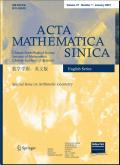Solution of the Center Problem for a Class of Polynomial Differential Systems
IF 0.8
3区 数学
Q2 MATHEMATICS
引用次数: 0
Abstract
Consider the polynomial differential system of degree m of the form
$$\eqalign{&\dot{x}=-y(1+\mu(a_{2}x-a_{1}y))+x(\nu(a_{1}x+a_{2}y)+\Omega_{m-1}(x,y)),\cr &\dot{y}=x(1+\mu(a_{2}x-a_{1}y))+y(\nu(a_{1}x+a_{2}y)+\Omega_{m-1}(x,y)),}$$
where μ and ν are real numbers such that \((\mu^{2}+\nu^{2})(\mu+\nu(m-2))(a_{1}^{2}+a_{2}^{2})\ne 0,m > 2\) and Ωm−1(x,y) is a homogenous polynomial of degree m − 1. A conjecture, stated in J. Differential Equations 2019, suggests that when ν = 1, this differential system has a weak center at the origin if and only if after a convenient linear change of variable (x,y) → (X,Y) the system is invariant under the transformation (X,Y,t) → (−X,Y, −t). For every degree m we prove the extension of this conjecture to any value of ν except for a finite set of values of μ.
一类多项式微分方程系统的中心问题求解
考虑形式为 $$\eqalign{&\dot{x}=-y(1+\mu(a_{2}x-a_{1}y))+x(\nu(a_{1}x+a_{2}y)+\Omega_{m-1}(x,y)),\cr &;\dot{y}=x(1+\mu(a_{2}x-a_{1}y))+y(\nu(a_{1}x+a_{2}y)+\Omega_{m-1}(x,y)),}$$ 其中 μ 和 ν 是实数,使得 \((\mu^{2}+\nu^{2})(\mu+\nu(m-2))(a_{1}^{2}+a_{2}^{2})\ne 0,m >;2)且 Ωm-1(x,y) 是一个度数为 m - 1 的同源多项式。2019 年微分方程杂志》(J. Differential Equations 2019)上的一个猜想表明,当 ν = 1 时,当且仅当变量(x,y)→(X,Y)经过方便的线性变化后,该微分系统在变换(X,Y,t)→(-X,Y, -t)下不变时,该微分系统在原点处有一个弱中心。对于每个阶数 m,我们都证明了这一猜想可以扩展到除了有限的 μ 值集合之外的任何 ν 值。
本文章由计算机程序翻译,如有差异,请以英文原文为准。
求助全文
约1分钟内获得全文
求助全文
来源期刊
CiteScore
1.00
自引率
0.00%
发文量
138
审稿时长
14.5 months
期刊介绍:
Acta Mathematica Sinica, established by the Chinese Mathematical Society in 1936, is the first and the best mathematical journal in China. In 1985, Acta Mathematica Sinica is divided into English Series and Chinese Series. The English Series is a monthly journal, publishing significant research papers from all branches of pure and applied mathematics. It provides authoritative reviews of current developments in mathematical research. Contributions are invited from researchers from all over the world.

 求助内容:
求助内容: 应助结果提醒方式:
应助结果提醒方式:


